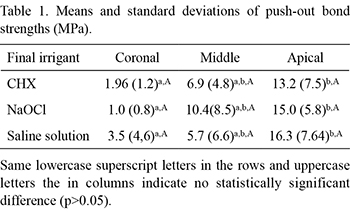The aim of this study was to evaluate the effects of different irrigants on sealer-dentin bond strength when using Real Seal. Thirty single-rooted teeth were divided into 3 groups. In one group, the teeth were irrigated with 3 mL of 2.5% NaOCl after each file change, flushed with 17% EDTA for 3 min and finally rinsed with 3 mL of 2.5% NaOCl. In the other two groups, rinse with NaOCl was replaced with 2% chlorhexidine gluconate (CHX) and 0.9% saline, respectively. Each root was sectioned transversally into apical, middle and coronal thirds to obtain 2-mm-thick slices. Each slice was filled with Real Seal and Resilon. Push-out test was used to analyze bond strength and failure modes were classified as adhesive, cohesive or mixed, according to SEM observations. The push-out test did not reveal any statistically significant difference (p>0.05) between the irrigants. However, the groups exhibited significantly different (p<0.05) bond strengths in terms of the root canal third. Higher bond strength was observed at the apical third when compared with coronal third, while middle third presented intermediary values. Fifteen specimens were analyzed by SEM (5 per group). Eleven specimens exhibited adhesive failures (5 in saline, 4 in NaOCl and 2 in CHX group); 2 cohesive failures were observed in the CHX group, and 1 mixed failure each was observed in the CHX and NaOCl groups. The tested irrigants did not influence the bond strength of Resilon and Real Seal to dentin. The apical third exhibited higher mean bond strengths and adhesive failures were predominant.
Endodontics; endodontic sealer; irrigation protocol; bond strength




